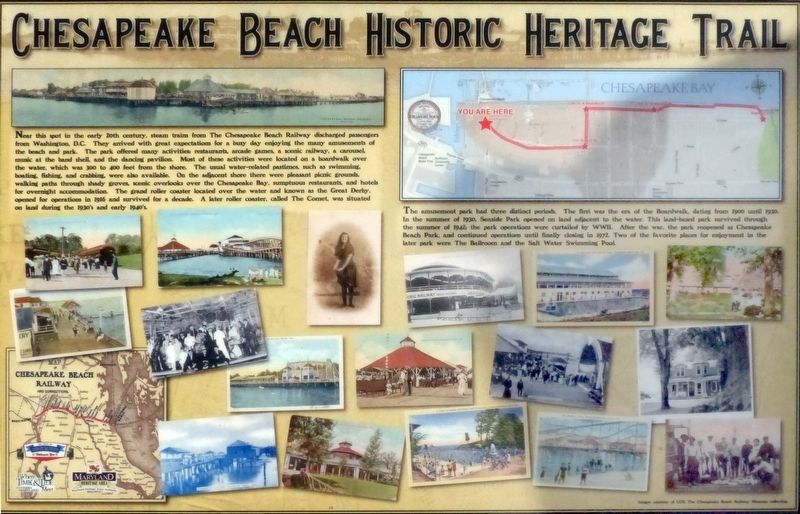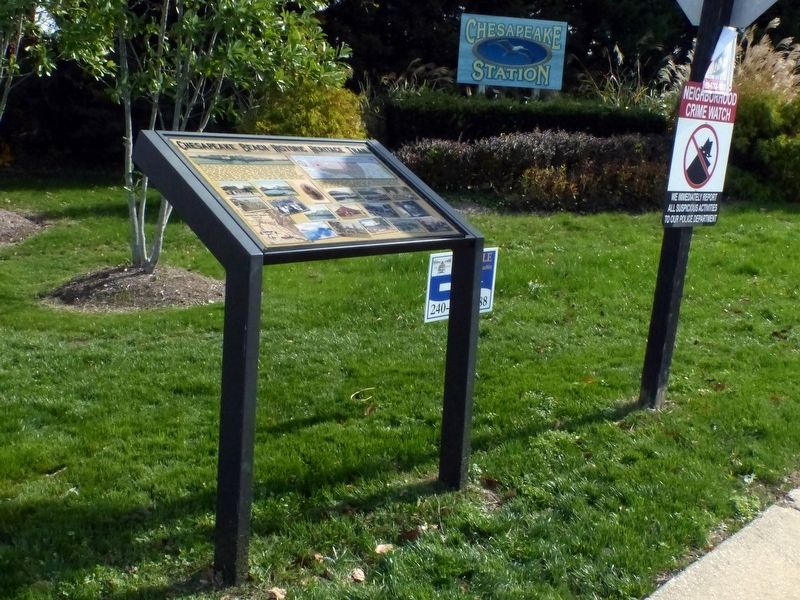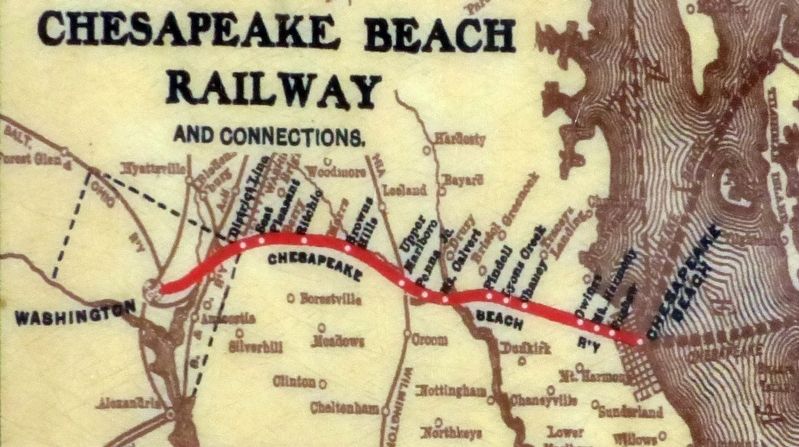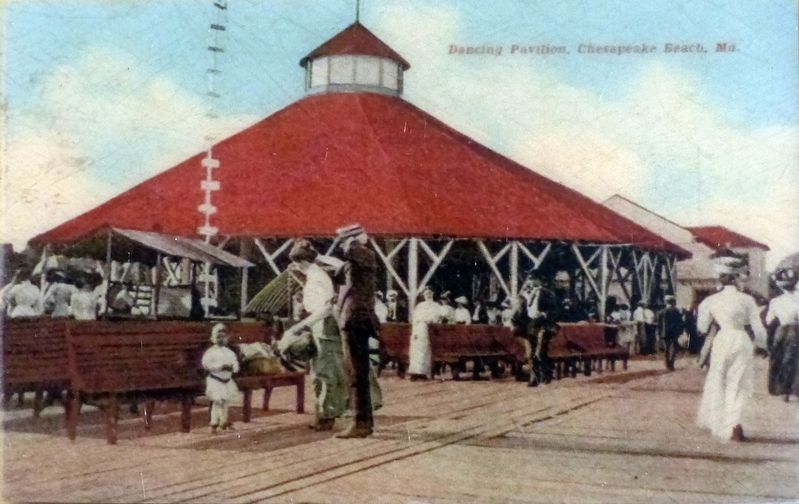Chesapeake Beach in Calvert County, Maryland — The American Northeast (Mid-Atlantic)
The Chesapeake Beach Railway
Chesapeake Beach Historic Heritage Trail
Near this spot in the early 20th century, steam trains from The Chesapeake Beach Railway discharged passengers from Washington DC. They arrived with great expectations for a busy day enjoying the many amusements of the beach and park. The park offered many activities: restaurants, arcade games, a scenic railway, a carousel, music at the band shell, and dancing pavilion. Most of these activities were located on the boardwalk over the water, which was 300 to 400 feet from the shore. The usual water-related pastimes, such as swimming, boating, fishing, and crabbing, were also available. On the adjacent shore there were pleasant picnic grounds, walking paths through shady groves, scenic overlooks over the Chesapeake Bay, sumptuous restaurants, and hotels for overnight accommodation. The grand roller coaster located over the water and known as the Great Derby, opened for operations in 1916 and survived for a decade. A Later roller coaster, called The Comet, was situated on land during the 1930’s and early 1940’s.
The amusement park had three distinct periods. The first was the era of the Boardwalk, dating from 1900 until 1930. In the summer of 1930, Seaside Park opened on land adjacent to the water. This land-based park survived through the summer of 1942; the park operations were curtailed by WWII. After the war, the park reopened as Chesapeake Beach Park, and continued operation until finally closing in 1972. Two of the favorite places for enjoyment in the later park were the Ballroom and the Salt Water Swimming Pool.
Topics. This historical marker is listed in these topic lists: Entertainment • Parks & Recreational Areas • Railroads & Streetcars.
Location. 38° 41.394′ N, 76° 32.055′ W. Marker is in Chesapeake Beach, Maryland, in Calvert County. Marker is at the intersection of Mears Avenue and C Street on Mears Avenue. Touch for map. Marker is at or near this postal address: 4192 Mears Avenue, Chesapeake Beach MD 20732, United States of America. Touch for directions.
Other nearby markers. At least 8 other markers are within walking distance of this marker. A different marker also named Chesapeake Beach Railway (within shouting distance of this marker); Railroad Artifacts At The Museum (within shouting distance of this marker); Chesapeake Beach Railway Station (within shouting distance of this marker); Railroad Bed (within shouting distance of this marker); a different marker also named Chesapeake Beach Railway (about 400 feet away, measured in a direct line); Bald Eagle (about 400 feet away); Abner's Crab House (approx. 0.2 miles away); Fishing Creek Aquatic Life (approx. 0.2 miles away). Touch for a list and map of all markers in Chesapeake Beach.

Photographed By Allen C. Browne, November 4, 2017
4. Chesapeake Beach Resort
This photo is on display at the Chesapeake Beach Railway Museum.
“Chesapeake Beach, as originally conceived, was a resort intended to rival Atlantic City and Coney Island. Its close proximity and rail construction to Washington, D.C. enticed thousands of visitors from the sweltering city to the cool breezes and salt water of the Chesapeake Bay. The boardwalk, which was destroyed in 1929-30, was lined with restaurants, souvenir shops, amusements, and games of chance.” – Chesapeake Beach Railway Museum.
“Chesapeake Beach, as originally conceived, was a resort intended to rival Atlantic City and Coney Island. Its close proximity and rail construction to Washington, D.C. enticed thousands of visitors from the sweltering city to the cool breezes and salt water of the Chesapeake Bay. The boardwalk, which was destroyed in 1929-30, was lined with restaurants, souvenir shops, amusements, and games of chance.” – Chesapeake Beach Railway Museum.
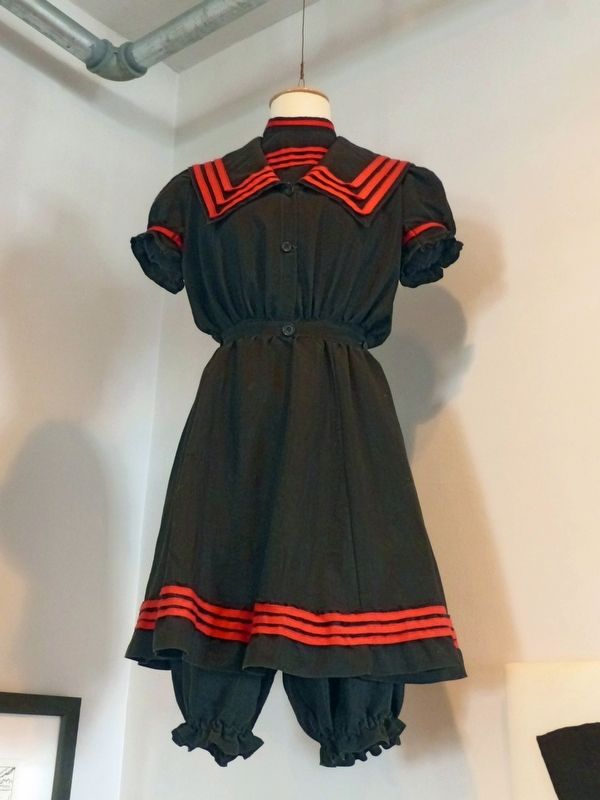
Photographed By Allen C. Browne, November 4, 2017
5. Woman’s Bathing Dress
c. 1900
c. 1900
On display at the Chesapeake Beach Railway Museum.
“The nautical style bathing dress was a popular standard style at the turn of the 20th century. The female body was well covered from head to toe in this swimming costume. A silk scarf or hat would have covered the head to complete the outfit. By the end of the first decade of the 20th century, women’s bathing suit fashions had adapted to more athletic and revealing styles.” –Chesapeake Beach Railway Museum
“The nautical style bathing dress was a popular standard style at the turn of the 20th century. The female body was well covered from head to toe in this swimming costume. A silk scarf or hat would have covered the head to complete the outfit. By the end of the first decade of the 20th century, women’s bathing suit fashions had adapted to more athletic and revealing styles.” –Chesapeake Beach Railway Museum
Credits. This page was last revised on December 18, 2020. It was originally submitted on November 6, 2017, by Allen C. Browne of Silver Spring, Maryland. This page has been viewed 621 times since then and 33 times this year. Photos: 1, 2, 3, 4, 5, 6. submitted on November 6, 2017, by Allen C. Browne of Silver Spring, Maryland. • Bill Pfingsten was the editor who published this page.
